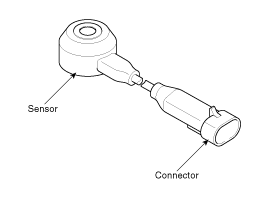 Hyundai Sonata: Knock Sensor (KS). Description and Operation
Hyundai Sonata: Knock Sensor (KS). Description and Operation
Description
Knocking is a phenomenon characterized by undesirable vibration and noise
and can cause engine damage. Knock Sensor (KS) is installed on the cylinder
block and senses engine knocking.
When knocking occurs, the vibration from the cylinder block is applied
as pressure to the piezoelectric element. When a knock occurs, the sensor produces
voltage signal. The ECM retards the ignition timing when knocking occurs. If
the knocking disappears after retarding the ignition timing, the ECM will advance
the ignition timing. This sequential control can improve engine power, torque
and fuel economy.

 Camshaft Position Sensor (CMPS). Repair procedures
Camshaft Position Sensor (CMPS). Repair procedures
Inspection
1.
Check the signal waveform of the CMPS and CKPS using the GDS.
Specification:
Refer to “Wave Form”
...
 Knock Sensor (KS). Specifications
Knock Sensor (KS). Specifications
Specification
Item
Specification
Capacitance (pF)
850 ~ 1,150
...
See also:
Tire rotation
To equalize tread wear, it is recommended that the tires be rotated every 7,500
miles (12,000 km) or sooner if irregular wear develops.
During rotation, check the tires for correct balance.
When r ...
Description and Operation
Cruise Control
The cruise control system is engaged by the cruise "ON/OFF" main switch
located on right of steering wheel column. The system has the capability to
cruise, coast, ac ...
Bulb wattage
...
